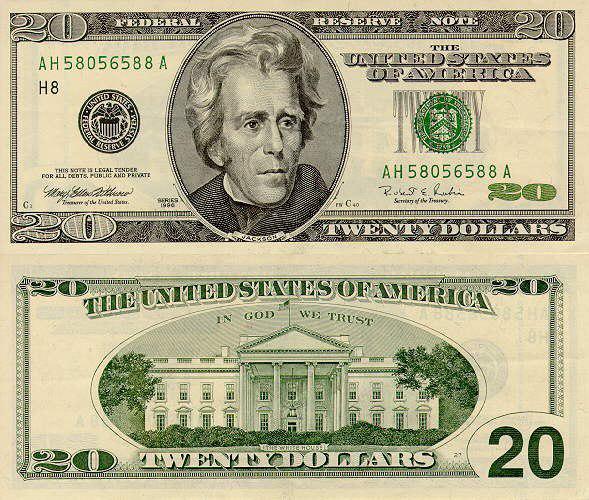912
PHENOMENON BAZERMANA: HOW TO SELL FOR $ 20 $ 204
Every year, Professor Max Bazerman sells to students MBA from Harvard Business School twenty-dollar bill much higher than the face value. His record - sale of $ 20 for $ 204. And he does it this way.

He shows the bill to the whole class and says that he would give $ 20 to the person who will give for it the most money. However, there is a small condition. The man, who was just behind the winner, will be required to give the professor the amount that he was willing to pay $ 20.
For example, two of the highest the bid was $ 15 and $ 16. The winner receives $ 20 in exchange for $ 16, and the second person will have to pay $ 15 to professor. These are the conditions.
Bidding starts at one dollar and quickly reach $ 12- $ 16. At this point, most students drop out of the auction, and there are only two people with the highest offers. Slowly but confidently auction approaches to the figure of $ 20.
It is clear that it is already impossible to win, but also did not want to lose, because the loser not only get nothing, but still will have to pay the face value of its latest Professor Bida.
Once the auction is transferred abroad at $ 21, the class explodes into laughter. Students of MBA, supposedly so smart, willing to pay for a twenty-dollar bill above par. Indeed, comical and very accurately describes the behavior of degree holders MBA.
However, the auction continues and quickly comes to $ 50, then to 100, up to $ 204 (the latter figure - a record Bazermana for his teaching career). Incidentally, during the training professor doing the same trick with top managers and CEO of large companies - and always sells $ 20 above face value (the money spent on charity).
Initially, all students feel that they have the opportunity to receive free money. They are not fools and will not pay more than twenty dollars for twenty-dollar bill. However, as soon as the bidding reach $ 12- $ 16, the second person understands that he faces a serious loss, so he starts bidit more than going until the auction does not reach $ 21. At this stage, both parties will lose money. But someone will lose all dollar, and someone twenty. To minimize losses, everyone tries to be a winner. However, this race leads only to the fact that both the auction participant loses more and more money, while the size of the losses does not reach such amount that a deeper hole to dig just does not make sense.
Thus, the desire to get Freestuff twenty turns around losses. And most interesting is that there are lots of data - especially in the stock market and in the casino - which show Bazermana phenomenon in action. The person starts to lose money. Rather than fix the loss, he hopes to be able to win back the loss - and almost always loses more and more money.
P.S. The explanation of the phenomenon on the fingers
For example, I suggest that anyone buy from me 100 dollars. At the auction. But on the condition that the person who will be the second - to pay them the amount offered.
One offered to buy 100 from me for $ 50, the second for 40. The first receives $ 100 for 50 - his profit $ 50. The second pays me for just 40 - his loss is $ 40. Naturally, he did not want to bear the loss, and he has 60 dollars. Accordingly, in this case, when you buy $ 100 of his earnings 40 and 50. The loss of another person, in turn, offered 50 USD. 100 also did not want to bear the loss - it makes a big bet. And so to the moment until the end of the cash or someone will stop.
As a result, because of the fear of losing money just (that is to become the second in the auction) rates reach much higher sums of $ 100, and the two are unjustified losses just because of the fact of loss aversion at an earlier stage of trading.

He shows the bill to the whole class and says that he would give $ 20 to the person who will give for it the most money. However, there is a small condition. The man, who was just behind the winner, will be required to give the professor the amount that he was willing to pay $ 20.
For example, two of the highest the bid was $ 15 and $ 16. The winner receives $ 20 in exchange for $ 16, and the second person will have to pay $ 15 to professor. These are the conditions.
Bidding starts at one dollar and quickly reach $ 12- $ 16. At this point, most students drop out of the auction, and there are only two people with the highest offers. Slowly but confidently auction approaches to the figure of $ 20.
It is clear that it is already impossible to win, but also did not want to lose, because the loser not only get nothing, but still will have to pay the face value of its latest Professor Bida.
Once the auction is transferred abroad at $ 21, the class explodes into laughter. Students of MBA, supposedly so smart, willing to pay for a twenty-dollar bill above par. Indeed, comical and very accurately describes the behavior of degree holders MBA.
However, the auction continues and quickly comes to $ 50, then to 100, up to $ 204 (the latter figure - a record Bazermana for his teaching career). Incidentally, during the training professor doing the same trick with top managers and CEO of large companies - and always sells $ 20 above face value (the money spent on charity).
Initially, all students feel that they have the opportunity to receive free money. They are not fools and will not pay more than twenty dollars for twenty-dollar bill. However, as soon as the bidding reach $ 12- $ 16, the second person understands that he faces a serious loss, so he starts bidit more than going until the auction does not reach $ 21. At this stage, both parties will lose money. But someone will lose all dollar, and someone twenty. To minimize losses, everyone tries to be a winner. However, this race leads only to the fact that both the auction participant loses more and more money, while the size of the losses does not reach such amount that a deeper hole to dig just does not make sense.
Thus, the desire to get Freestuff twenty turns around losses. And most interesting is that there are lots of data - especially in the stock market and in the casino - which show Bazermana phenomenon in action. The person starts to lose money. Rather than fix the loss, he hopes to be able to win back the loss - and almost always loses more and more money.
P.S. The explanation of the phenomenon on the fingers
For example, I suggest that anyone buy from me 100 dollars. At the auction. But on the condition that the person who will be the second - to pay them the amount offered.
One offered to buy 100 from me for $ 50, the second for 40. The first receives $ 100 for 50 - his profit $ 50. The second pays me for just 40 - his loss is $ 40. Naturally, he did not want to bear the loss, and he has 60 dollars. Accordingly, in this case, when you buy $ 100 of his earnings 40 and 50. The loss of another person, in turn, offered 50 USD. 100 also did not want to bear the loss - it makes a big bet. And so to the moment until the end of the cash or someone will stop.
As a result, because of the fear of losing money just (that is to become the second in the auction) rates reach much higher sums of $ 100, and the two are unjustified losses just because of the fact of loss aversion at an earlier stage of trading.
Ask Ethan №10: Why is the universe is the same everywhere
David Fincher - director with extraordinary charisma. HISTORY OF SUCCESS.























